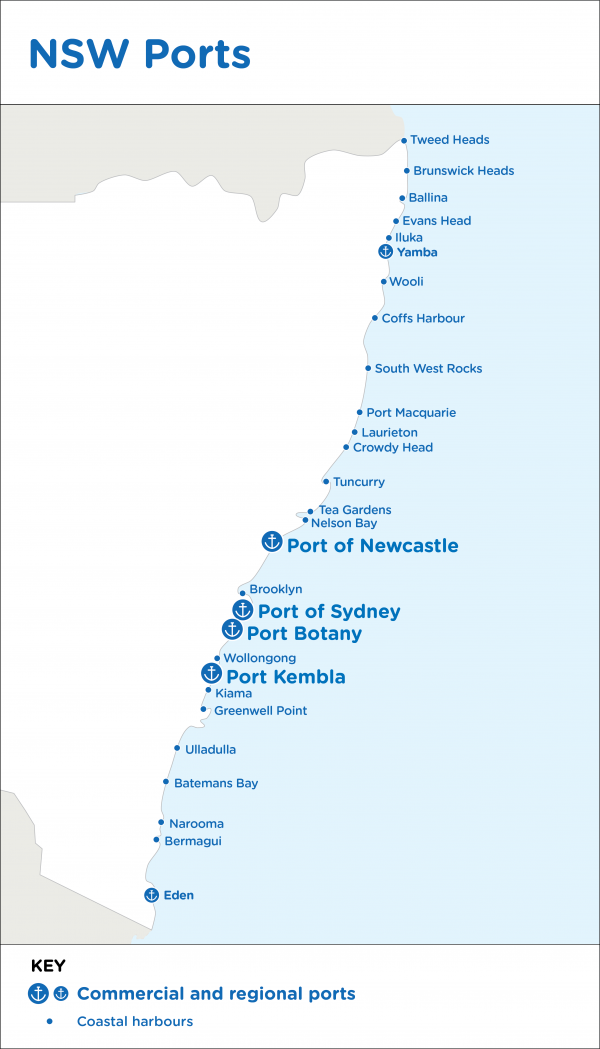
NSW port network
Map of ports by local government area.
NSW’s major ports of Port Botany, Port Jackson, Port Kembla and the Port of Newcastle are its trade gateways to the world.
Our ports provide a critical link between the landside and seaside elements of the supply chain and play a key role in supporting the growth in all import and export trade. Port Botany contributes $3.2 billion to NSW's Gross State Product, while Port Kembla contributes $760 million.
Port Botany is NSW’s largest container port, while the Port of Newcastle is one of the world’s leading coal export ports. Port Kembla is the country’s biggest vehicle import centre, and the key grain export port for Southern and South Western NSW producers.
Image

Image controls:
Management of our ports
Private sector organisations are responsible for the commercial management of Port Botany, Port Kembla and Newcastle which are NSW’s major ports:
- NSW Ports – manages Port Botany and Port Kembla under a 99-year lease agreement commencing in 2013
- Port of Newcastle – manages the Newcastle Port under a 98-year lease agreement commencing in 2014.
The port transactions raised $6.82 billion for the State and the net proceeds were invested into the NSW Government’s infrastructure fund, Restart NSW.
The commercial management of Port Jackson (Sydney Harbour), Port of Yamba and Port of Eden is undertaken by the Port Authority of New South Wales which is a State Owned Corporation.
Smaller regional ports such as Coffs Harbour, Lord Howe Island, Port Macquarie, Jervis Bay are managed by Transport for NSW for trading vessel and cruise vessel visits.
The Port Authority of New South Wales, which commenced operations in July 2014, is responsible for the port safety aspects of all shipping using Port Botany, Port Jackson, Port Kembla, Newcastle, Eden and Yamba, under the Port Safety Operating Licence issued by the Minister for Roads, Maritime and Freight and administered by TfNSW. This includes
- Harbour masters and marine pilotage
- Navigation services (including vessel traffic services).
- Marine pollution and emergency response
- Dangerous goods management.
Transport for NSW performs these safety functions for the smaller regional ports, when required, for trading and cruise vessel visits.
Role of Transport for NSW in ports
Transport for NSW drives strategies to improve efficiency to and from NSW’s ports, as well as ensuring there are appropriate mechanisms in place to maintain high standards of marine safety and environmental protection in the trading ports and coastal waters of NSW.
Where required, we provide Ports Corporations and the NSW Ports Consortium with access to up-to-date freight information and modelling to support long-term port capacity planning.
Through the Cargo Movement Coordination Centre, we are working with industry to optimise how cargo moves through Port Botany, Port Kembla and regional NSW across supply chain interfaces and networks.
Port growth plans to meet future freight volumes
Long-term plans for the growth of ports are key for meeting the challenge of growing trade volumes being experienced by NSW international maritime gateways.
The NSW Ports’ 30 Year Master Plan (link is external) (released in October 2015) outlines five objectives to sustainably cater for forecast trade growth at Port Botany and Port Kembla:
- Providing efficient road and rail connections to the ports and intermodal terminals
- Growing rail transport of containers
- Using land infrastructure efficiently
- Growing port capacity
- Protecting the ports and intermodal terminals from urban encroachment.
Read more
Ports legislation
Transport for NSW drives strategies to improve efficiency at the ports of NSW, as well as ensuring there are appropriate mechanisms in place
Marine Pilotage Code
Pilotage is the service by skilled professionals to navigate a vessel into, within or out of port waters.
Dangerous goods
Dangerous goods are classified as substances and articles that pose an extreme risk to people, property and the environment.
National Voluntary Guidelines for Stevedores
Voluntary guidelines for the introduction of any new stevedore landside charges, notification periods and explanation of price increases.
